Looking for Help with Assignments?
-RUCats has 80 hours of tutoring available online and in-person. Check the tutoring tab in Canvas!
-Instructors and Lead TAs have a combined 10 hours of Office Hours, open to all sections. See times/locations here.
-Piazza (found in the Canvas sidebar) provides fast support from Course Staff and other Students. Be sure to search to see if someone has asked a similar question!
-If you need a computer to complete work on, iLab machines can be found in the CAVE (Hill 252) and surrounding rooms.
Conway Game of Life – 98 course points
The purpose of this assignment is to practice your understanding of 2D arrays and union-find.
Start your assignment early! You need time to understand the assignment and to answer the many questions that will arise as you read the description and the code provided.
Refer to our Programming Assignments FAQ for instructions on how to install VSCode, how to use the command line and how to submit your assignments.
- See this video on how to import the project into VSCode and how to submit into Autolab.
The assignment has two components:
- Coding (95 points) submitted through Autolab.
- Reflection (3 points) submitted through a form.
- Submit the reflection AFTER you have completed the coding component.
- Be sure to sign in with your RU credentials! (netid@scarletmail.rutgers.edu)
- You cannot resubmit reflections but you can edit your responses before the deadline by clicking the Google Form link, signing in with their netid, and selecting “Edit your response”
Overview
Conway Game of Life is a cellular discrete model of computation devised by John Horton Conway. The game consists of a game board (grid) of n x m cells, each in one of two states, alive or dead.
The game starts with an initial pattern, then it will change what cells are alive or dead from one generation to the next depending on a set of rules. As the Game of Life continues, the game will keep making a new generation (based on the preceding one) until it reaches one of three states.
Cells
Each cell can be in one of two states, alive or dead, and it has 8 neighboring cells which are the cells that are horizontally, vertically, or diagonally adjacent. The figure below exemplifies neighboring cells on a game board of 4 x 4 cells.

Rules of the Game
The game starts with a initial set of alive cells (this is the first generation). The next generation evolves from applying the following rules simultaneously to every cell on the game board, i.e. births and deaths happen simultaneously. Afterwards, the rules are iteratively applied to create future generations. Each generation depends exclusively on the preceding one.
Rule 1
Alive cells with no neighbors or one neighbor die of loneliness.
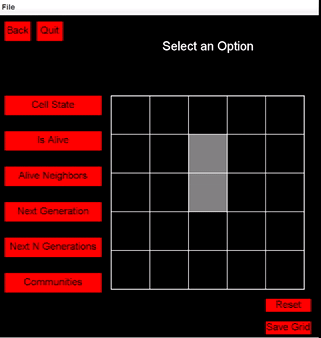
Rule 3
Alive cells with two or three neighbors survive.

Rule 2
Dead cells with exactly three neighbors become alive by reproduction.
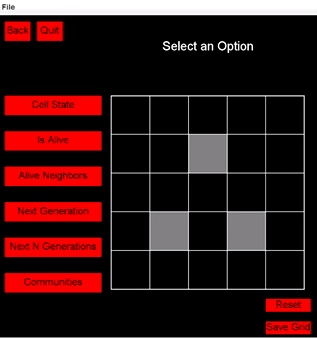
Rule 4
Alive cells with four or more neighbors die of overpopulation.
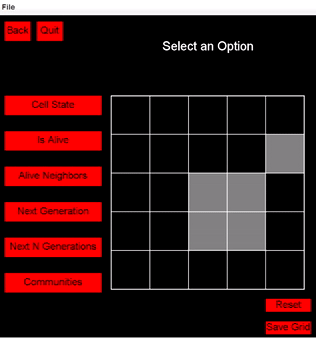
States for the Game
There are three states that the game can reach in regards to the rules provided.
- There are no more living cells for the next generation.
- There are living cells, but the next generation is the same as the last (stable game).
- The next generation infinitely cycles throughout the game.
Note that there are more scenarios for states 2 and 3, these are just one example for each.
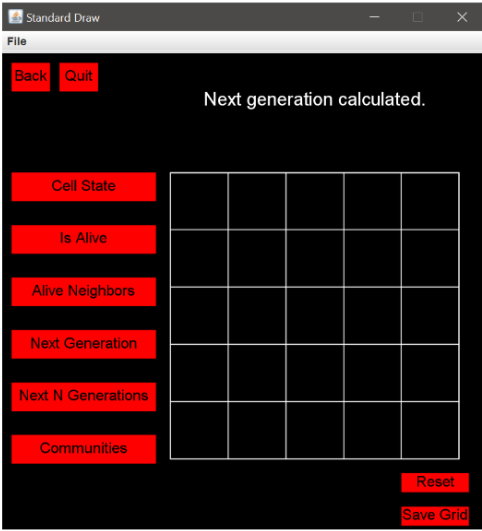
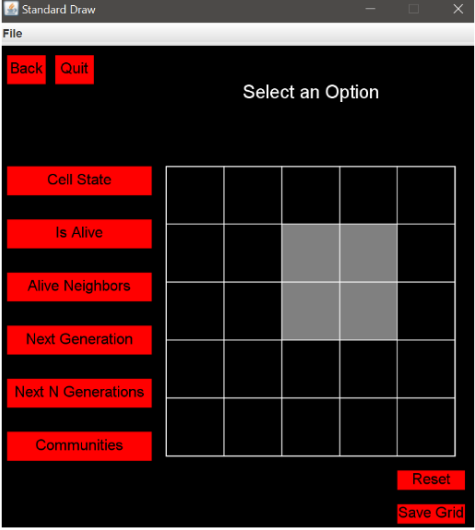
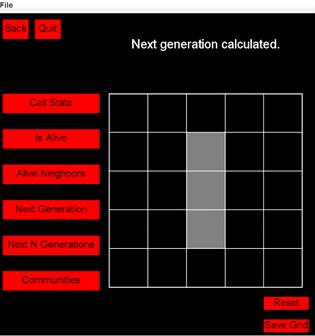
Implementation
Overview of files provided
- GameOfLife class holds all of the methods to be written that will then be tested when running the game. Edit the empty methods with you solution, but DO NOT edit the provided ones or the methods signatures of any method. This is the file you submit.
- WeightedQuickUnionUF class, which houses the union-find data type. Do not edit this class. This newly learned algorithm holds two useful methods to operate on a given data structure. The
findmethod will return a parent index of an array given the element you are looking for. Theunionmethod finds the parent of two elements given and will determine how to join the two elements together. You will need to utilize an instance of this class in the GameOfLife class to compute the number of communities of cells. - Driver class, which is used to launch the Game Of Life and test the various methods. You can run the driver by simply hitting the run button above the main method or clicking the run button in the top right of the IDE (recommended). Alternatively you can type in java Driver in the IDE terminal (just make sure you are in the correct directory with the ls command and make sure everything is compiled, look at “Executing And Debugging” section below for more info). Feel free to edit this class, as it is provided only to help you test. It is not submitted and it is not used to grade your code.
- Board, Button, Page, Rectangle, Text, and StdDraw classes hold various methods to support the interactive driver.
- StdIn and StdOut, which are used by the driver. Do not edit these classes..
- Multiple text files (grid0.txt, grid1.txt, grid2.txt, grid3.txt, grid4.txt, grid5.txt, grid6.txt, grid7.txt) which contain the initial pattern, and are read by the driver as test cases. Feel free to edit them or even make new ones to help test your code. They are not submitted.
GameOfLife.java
- DO NOT add new import statements.
- DO NOT change any of the method’s signatures.
Methods to be implemented by you:
1. GameOfLife – One argument constructor
- This method builds your game board (grid) from the input file (initial game pattern).
- You have been provided some input files to test this method (input1.txt, input2.txt, input3.txt). The format is as follows:
- One line containing the number of rows in the board game
- One line containing the number of columns in the board game
- Several lines (one for each row) containing the cell state (false for dead, true for alive) for each column in the board, space separated
Use the StdIn library to read from a file:
StdIn.setFile(filename)opens a file to be readStdIn.readInt()reads the next integer value from the opened file (weather the value is in the current line or in the next line)StdIn.readBoolean()read the next boolean value from the opened file (weather the value is in the current line or in the next line)
Submit this method and the getCellState() method under “Early Submission” for extra credit.
2. getCellState
Given two integers representing the cell row and column this method returns true if the cell is alive and false if the cell is dead.
Test this method using the driver:
- upon clicking the button Cell State you will be prompted to select a cell
- select a cell by clicking in one square
- the selected cell will light up red and the driver will state whether the cell is living or dead.

3. isAlive
Returns true or false based on whether or not there are living cells within the board (grid)
Test this method using the driver. Click on the Is Alive button and the driver will display whether or not there are living cells on the board game.

4. numOfAliveNeighbors
Given two integers representing the cell row and column this method returns the cell’s number of alive neighbors of a maximum of 8 neighbors.
Test this method using the driver:
- upon clicking the button Alive Neighbors you will be prompted to select a cell
- select a cell by clicking in one square
- the selected cell will light up red and the driver will state the total number of alive cells around the selected cell

5. computeNewGrid
This is where you will be using the rules of the game (stated above) to compute the next generation of cells.
- create a new board (grid) to be returned, representing the new generation
- for each cell, use the numOfAliveNeighbors method to determine how many cells are alive around a cell
- then using the number of alive neighbors with the rules of the game determine if the cell will be set to be alive or dead in the new grid
6. nextGeneration
Update the board (grid) with the board returned by the computeNewGrid method.
Test this and the computeNewGrid methods using the driver by clicking the Next Generation button.
The driver will state Next generation calculated.

7. nextGeneration – One argument
The input integer parameter represents the number of generations to compute (fast forward).
Test this methods using the driver:
- upon clicking the Next N Generations button you will be prompted to enter a number
- enter a number and click the Submit button
- the driver will state that the board has evolved the number of generations requested

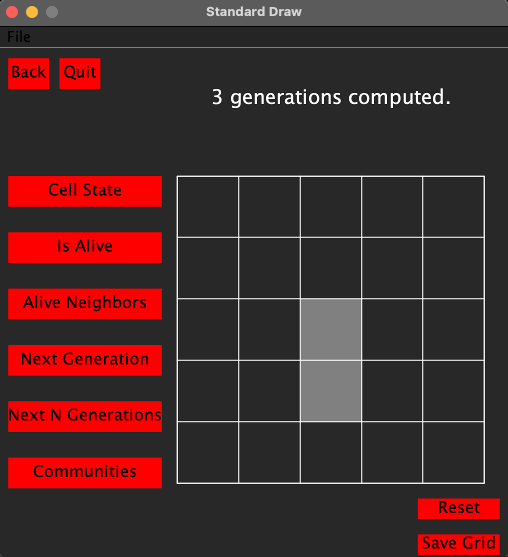
8. numberOfCommunities
This method computes and returns the number of separate communities of cells in the board. A community is made of connected cells.
- Cells from separate communities are not connected.
In algorithm Weighted Quick Union UF each community (connected component) is a tree. The community’s representative is the root of the tree.
- To connect two cells use the union method
- To find the root of the tree a cell belongs to use the find method
- To find the number of communities count the number of unique roots of trees
Test this methods using the driver by clicking the Communities button.
The driver will state the number of communities currently on the board.
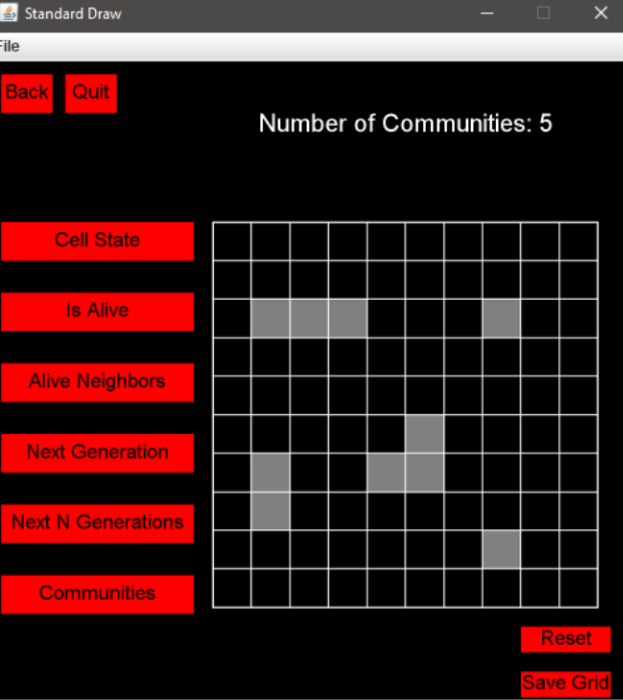
Find below the expected outputs after going through one generation of grids 1-6

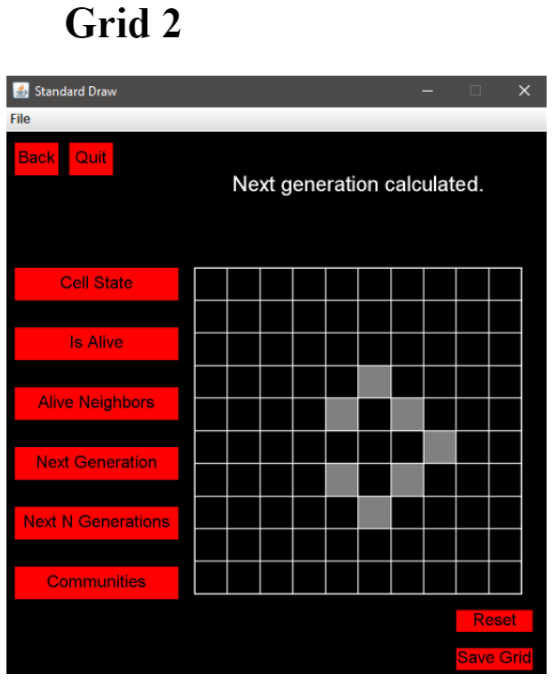

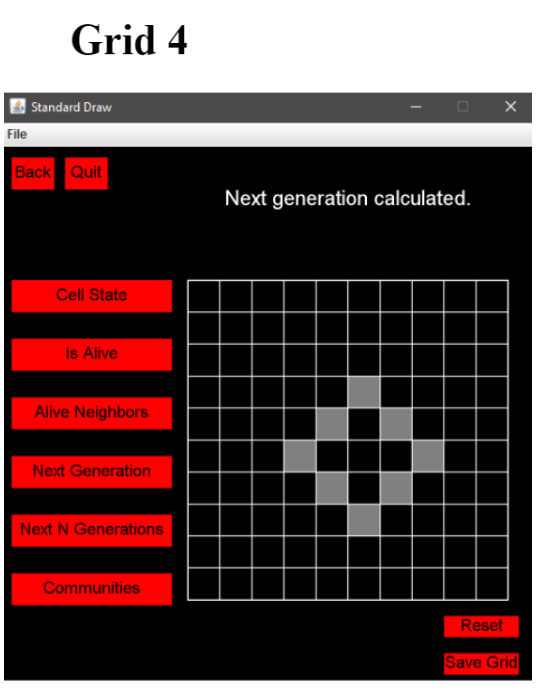
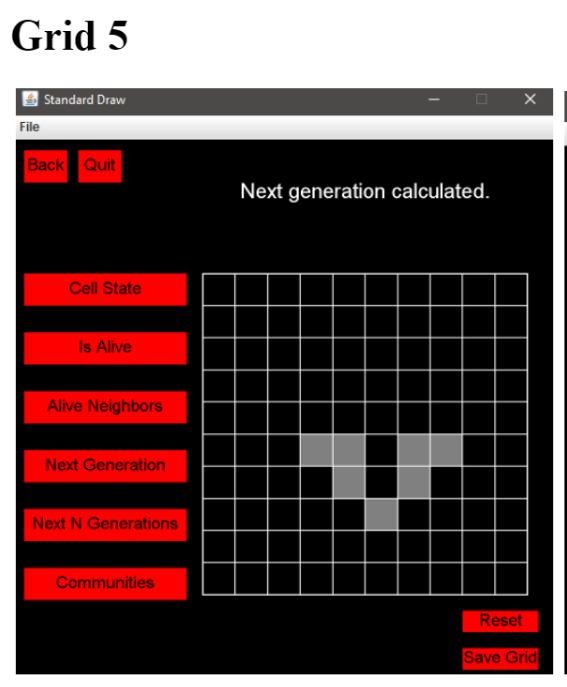

Still don’t understand how Union-Find works?
Here is a visualization using a 16×16 grid with two communities:
- one community is formed by cells: 21, 22, 23, 24, 36, 37, 38, 39, 40, 41, 53, 54, 55, 56, 57, 70, 71
- the other community is formed by cells: 139, 140, 153, 154,155, 156, 157, 158, 159, 169, 170, 173, 174, 175, 184, 185, 186, 187, 189, 190, 191, 200, 201, 202, 206, 217, 218, 219, 220 221, 222, 235, 236, 237.
The Weighted Union-Find algorithm will enable the detection that there are two communities.
Here is how it works:
1. Instantiate a WeightedQuickUnionUF object.
2. Start by setting each cell’s parent to itself.
Note: the numbers on the grid are the cell’s parent cell number.

Union every live cell to any neighboring live cell.
3. Consider each cell in the grid array individually. In this example, when we consider cell 21, and check all of its neighbors (all 8 directions!)
- Since 22, 36, 37, and 38 are neighboring cells that are not dead, we union (connect) them. Connect them using the WeightedQuickUnionUF object.

Once we are done with inspecting all cells from the community:
- All live cells neighboring 21 will have cell 21 as their parent.
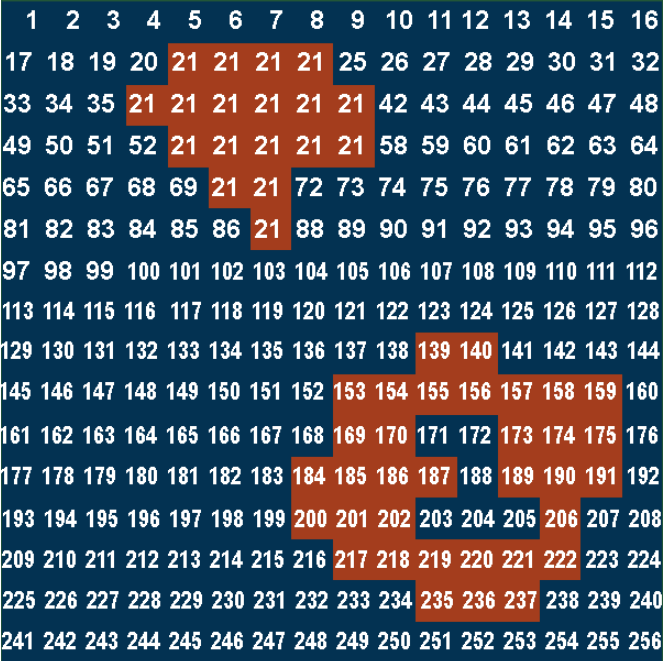
Once we are done with inspecting all cells on the grid array.

Now that we have all of the connected live cells unioned, find the unique nodes!
- Iterate through the grid array once again.
- For every cell that is alive
- Find its root node () and check if that root node is already accounted for.
- If it is not accounted for, increment a counter.
- If it is accounted for, skip it and continue on.
- Once you are done iterating through the grid, the counter contains the number of islands there are!
Result for example above – accounted nodes: [ 21, 139 ]
Thus, for this example, our result would be 2.
Now that you understand Union-Find conceptually, take a look at the WeightedQuickUnionUF.java file to better understand how to implement it!
Implementation Notes
- YOU MAY only update the methods GameOfLive(String), getCellState(), isAlive(), numOfAliveNeighbors(), computeNewGrid(), nextGeneration(), nextGeneration(int), and numOfCommunities().
- DO NOT add any instance variables to the GameOfLive class.
- DO NOT add any public methods to the GameOfLive class.
- YOU MAY add private methods to the GameOfLive class.
- DO NOT use System.exit()
VSCode Extensions
You can install VSCode extension packs for Java. Take a look at this tutorial. We suggest:
Importing VSCode Project
- Download GameOfLife.zip from Autolab Attachments.
- Unzip the file by double clicking.
- Open VSCode
- Import the folder to a workspace through File > Open
Executing and Debugging
- You can run your program through VSCode or you can use the Terminal to compile and execute. We suggest running through VSCode because it will give you the option to debug.
- How to debug your code
- If you choose the Terminal:
- first navigate to GameOfLife directory/folder
- to compile: javac -d bin src/conwaygame/*.java
- to execute: java -cp bin conwaygame.Driver
- first navigate to GameOfLife directory/folder
Before submission
Collaboration policy. Read our collaboration policy here.
Submitting the assignment. Submit GameOfLife.java separately via the web submission system called Autolab. To do this, click the Assignments link from the course website; click the Submit link for that assignment.
Getting help
If anything is unclear, don’t hesitate to drop by office hours or post a question on Piazza.
- Find instructors office hours here
- Find tutors office hours on Canvas -> Tutoring
- Find head TAs office hours here
- In addition to office hours we have the CAVE (Collaborative Academic Versatile Environment), a community space staffed with lab assistants which are undergraduate students further along the CS major to answer questions.
Problem by Seth Kelly and Maxwell Goldberg

